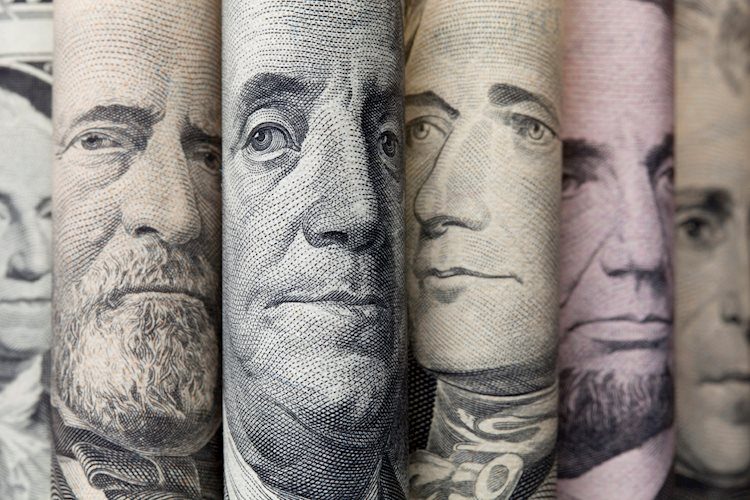
- The DXY Index rose above the 20-day SMA towards 104.05 and will close a 0.75% winning week.
- US NFPs from November accelerated, as did Average Hourly Earnings. The Unemployment Rate declined.
- US is set to report CPI inflation next Tuesday.
The US Dollar (USD) continued to command the financial markets as it soared to the 104.05 mark, primarily because of positive labor market figures and a surge in yields, which suggests that markets are delaying rate cuts in 2024. The gains for the USD Index (DXY) were fueled by economic reports from November, prominently Average Hourly Earnings, Unemployment Rate and Nonfarm Payrolls, all of which collectively fuelled hawkish bets on the Federal Reserve (Fed).
Moderating US inflation figures from October fuelled dovish expectations regarding the Federal Reserve’s stance at the beginning of November. However, Fed officials’ signals considering further tightening are dampening these expectations, and strong labor market data reaffirms this cautious stance by the bank, which is requesting further evidence on the economy cooling down. The upcoming inflation data from November and the Fed meeting next week will be critical determinants for the USD’s short-term trajectory.
Daily Market Movers: US Dollar rising on the strength of labor market data
- The US dollar is making gains today, riding on a wave of strong labor market data and climbing yields.
- According to the US Bureau of Labor Statistics, November’s Average Hourly Earnings MoM figures revealed a better-than-expected increase of 0.4%, exceeding both consensus and previous numbers of 0.3% and 0.2%, respectively.
- The Nonfarm Payrolls for November showed 199K new jobs were added to the US economy, surpassing consensus expectations of 180K and the preceding number of 150K jobs.
- The Unemployment Rate came in at 3.7%, lower than the anticipated figure of 3.9%.
- US bond yields are rising, with rates for 2-year, 5-year and 10-year bonds rising to 4.72%, 4.24%, and 4.23%, respectively.
- As per the CME FedWatch Tool, the market expects no rate hike in the December Fed meeting but anticipates less easing in 2024.
- Next week will see Tuesday’s release of the Headline and Core Consumer Price Index (CPI) for November, which will likely shape the expectations for the next Fed decisions.
Technical Analysis: US Dollar bulls step in, but bears are still in command
The indicators on the daily chart reflect a short-term conflicted landscape for the US Dollar. The Relative Strength Index (RSI) position is on a positive slope, albeit in negative territory. This signals growing buying momentum, but it isn’t robust enough to draw a definitive recovery. On the other hand, the histogram of the Moving Average Convergence Divergence (MACD) indicator paints a similar picture with green bars, which suggests that the selling pressure is declining.
Regarding the Simple Moving Averages (SMAs), the index sits above the 20-day SMA, yet below the 100-day SMA. Nonetheless, with respect to the 200-day SMA, it is clear that the index is operating in a generally bullish zone.
The resilience of bulls, in combination with bears taking a breather, insinuates that the selling force could be losing dominance over the buying force. However, the US Dollar Index needs to make a sustained move above the 100-day SMA for a change in the prevailing selling momentum. Until then, the overall technical outlook remains tentatively balanced toward the downside.
Support levels: 104.00 (20-day SMA), 103.50, 103.30.
Resistance levels: 104.40 (100-day SMA), 104.50,104.70.
Inflation FAQs
Inflation measures the rise in the price of a representative basket of goods and services. Headline inflation is usually expressed as a percentage change on a month-on-month (MoM) and year-on-year (YoY) basis. Core inflation excludes more volatile elements such as food and fuel which can fluctuate because of geopolitical and seasonal factors. Core inflation is the figure economists focus on and is the level targeted by central banks, which are mandated to keep inflation at a manageable level, usually around 2%.
The Consumer Price Index (CPI) measures the change in prices of a basket of goods and services over a period of time. It is usually expressed as a percentage change on a month-on-month (MoM) and year-on-year (YoY) basis. Core CPI is the figure targeted by central banks as it excludes volatile food and fuel inputs. When Core CPI rises above 2% it usually results in higher interest rates and vice versa when it falls below 2%. Since higher interest rates are positive for a currency, higher inflation usually results in a stronger currency. The opposite is true when inflation falls.
Although it may seem counter-intuitive, high inflation in a country pushes up the value of its currency and vice versa for lower inflation. This is because the central bank will normally raise interest rates to combat the higher inflation, which attract more global capital inflows from investors looking for a lucrative place to park their money.
Formerly, Gold was the asset investors turned to in times of high inflation because it preserved its value, and whilst investors will often still buy Gold for its safe-haven properties in times of extreme market turmoil, this is not the case most of the time. This is because when inflation is high, central banks will put up interest rates to combat it.
Higher interest rates are negative for Gold because they increase the opportunity-cost of holding Gold vis-a-vis an interest-bearing asset or placing the money in a cash deposit account. On the flipside, lower inflation tends to be positive for Gold as it brings interest rates down, making the bright metal a more viable investment alternative.
- SEO Powered Content & PR Distribution. Get Amplified Today.
- PlatoData.Network Vertical Generative Ai. Empower Yourself. Access Here.
- PlatoAiStream. Web3 Intelligence. Knowledge Amplified. Access Here.
- PlatoESG. Carbon, CleanTech, Energy, Environment, Solar, Waste Management. Access Here.
- PlatoHealth. Biotech and Clinical Trials Intelligence. Access Here.
- Source: https://www.fxstreet.com/news/us-dollar-trades-with-gains-amid-strong-labor-market-data-and-rising-yields-202312081820



